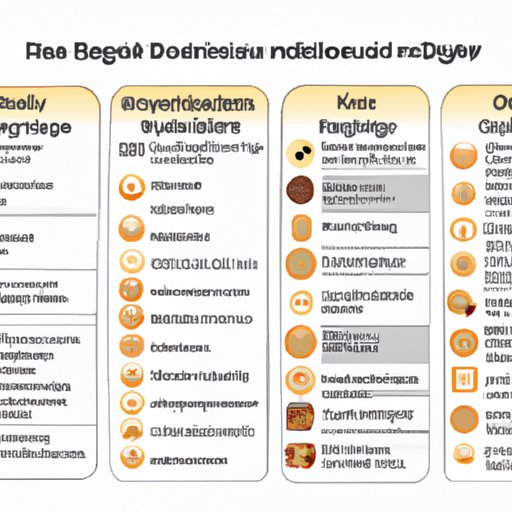Introduction
Diabetes is a serious medical condition that requires careful management, especially when it comes to diet and nutrition. For diabetics, eating the right foods can help to manage their blood sugar levels and prevent long-term complications. But with so many different types of food available, it can be difficult to know what is the best breakfast cereal for diabetics to eat.
This article will explore the nutritional needs of diabetics, analyze the nutritional content of breakfast cereals, examine the glycemic index of breakfast cereals, explore low-glycemic cereal alternatives, examine high-fiber, low sugar cereal options, compare natural vs. processed breakfast cereals, and create delicious and healthy diabetic-friendly breakfast recipes.

Analyzing the Nutritional Content of Cereals for Diabetics
When it comes to selecting breakfast cereals for diabetics, it is important to consider the necessary macronutrients and micronutrients they need to stay healthy. According to the American Diabetes Association, diabetics should focus on foods that are rich in vitamins, minerals, fiber, and healthy fats, while limiting foods that are high in added sugars, saturated fats, and sodium.
It is also important to examine the sugar and carbohydrate content of breakfast cereals. While some cereals may be labeled as “sugar-free” or “low-carb,” these terms can be misleading. For example, some cereals may contain natural sweeteners such as agave nectar or honey, which can still raise blood sugar levels. It is important to look closely at the nutrition label to determine the exact amount of sugar and carbohydrates per serving.
What is the Glycemic Index of Breakfast Cereals?
The glycemic index (GI) is a measure of how quickly and how much a particular food raises blood sugar levels. Foods that have a low GI score (under 55) are digested more slowly and don’t cause a sudden spike in blood sugar levels. On the other hand, foods that have a high GI score (over 70) are digested quickly and can cause a rapid increase in blood sugar levels.
Examples of breakfast cereals with a low GI score include oats, muesli, All-Bran, and Shredded Wheat. Examples of breakfast cereals with a high GI score include Corn Flakes, Rice Krispies, and Special K. It is important to note that the GI score of a food can vary depending on the brand and the way it is prepared.
Exploring Low-Glycemic Cereal Alternatives
Oatmeal is a popular breakfast cereal option for diabetics, as it has a low GI score and is high in fiber. Oats are also packed with vitamins, minerals, and antioxidants, making them a nutritious choice. Quinoa is another low GI cereal alternative that is high in protein, fiber, and other essential nutrients. Other low GI cereal options include barley, buckwheat, and rye.
Examining High-Fiber, Low Sugar Cereal Options
High-fiber cereals are an excellent choice for diabetics, as they can help to stabilize blood sugar levels and keep you feeling full longer. Popular high-fiber breakfast cereals include bran flakes, wheat germ, and granola. It is important to look for cereals that are low in added sugar, as this can quickly add up and put your blood sugar levels at risk.
Comparing Natural vs. Processed Breakfast Cereals
When selecting breakfast cereals for diabetics, it is important to consider whether the cereal is natural or processed. Natural cereals are those that are made from whole grains and are free from added sugars, preservatives, and artificial flavors. Processed cereals are those that are made from refined grains and may contain added sugars, preservatives, and artificial flavors.
Natural cereals tend to be higher in fiber and lower in added sugars, which makes them a better choice for diabetics. However, processed cereals can be a convenient and tasty option for those who are short on time. When choosing between natural and processed cereals, it is important to read the nutrition labels carefully to ensure that the cereal is low in added sugars and high in fiber.
Creating Delicious and Healthy Diabetic-Friendly Breakfast Recipes
Once you have selected a breakfast cereal, it is time to get creative and start making delicious and healthy diabetic-friendly breakfast recipes. Ideas for low GI breakfast recipes include overnight oats, quinoa porridge, and chia pudding. Tips for making healthy and delicious recipes include adding fresh fruits and vegetables, nuts and seeds, and unsweetened dairy products like yogurt or milk.
Conclusion
When selecting breakfast cereals for diabetics, it is important to consider the glycemic index, the amount of sugar and carbohydrates, and the type of cereal (natural vs. processed). Low GI cereals such as oats, muesli, and quinoa are excellent choices for diabetics, as are high-fiber, low sugar cereals such as bran flakes and wheat germ. Finally, it is important to get creative and make delicious and healthy diabetic-friendly breakfast recipes.
In conclusion, diabetics should focus on selecting breakfast cereals that are low GI, high-fiber, and either natural or processed. With the right breakfast cereal, diabetics can enjoy a delicious and nutritious meal that will help to keep their blood sugar levels in check.
(Note: Is this article not meeting your expectations? Do you have knowledge or insights to share? Unlock new opportunities and expand your reach by joining our authors team. Click Registration to join us and share your expertise with our readers.)
